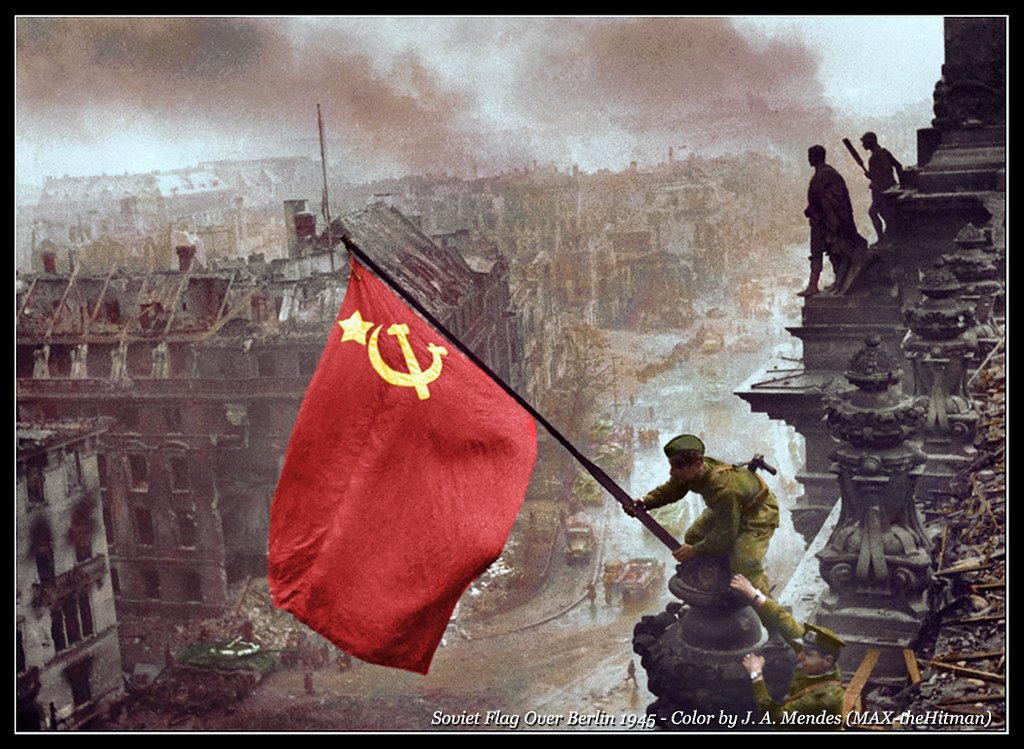The Last Weeks Leading to Hitler’s Downfall
By Sergio Rodríguez Gelfenstein
Editor’s Note:
Since February 2023, in commemoration of the 80th anniversary of the Soviet victory at Stalingrad, I have published a series of articles dedicated to remembering and honoring the unparalleled struggle of the Soviet peoples during the Great Patriotic War. This article marks the final installment of the seven-part series, documenting the decisive moments that culminated in the downfall of Nazi Germany.
Countdown to Berlin
On March 9, 1945, the Soviet High Command issued the final operational orders for what would become the climactic campaign of World War II: the assault on Berlin. This battle was not only military in nature—it would shape the geopolitical structure of the postwar world. For the Soviets, victory had to mean the complete eradication of fascism in Germany, both as a political system and a social force.
The Soviet strategy for capturing Berlin included eliminating the enemy’s central command and occupying the Ruhr, Germany’s industrial and mining heartland. Simultaneously, the Soviet command had to account for the actions of British and American forces advancing from the West, who aimed to seize southern Germany and potentially reach Austria and Czechoslovakia. Although the Yalta Conference had demarcated spheres of influence and confirmed that Berlin lay within the Soviet zone, the British made little effort to conceal their ambition to take the German capital first. Thus, unity among the Allies was tenuous—each pursued its own strategic objectives.
Distrust Among Allies
The Soviet leadership, wary of Anglo-American intentions, suspected that the British and Americans were pursuing separate peace talks with German forces. The aim: to preserve the German army as a future asset against the Soviet Union. Indeed, the German military redirected troops from the Western to the Eastern Front to slow the Red Army’s advance and ease pressure on the Western Allies.
Increasingly, Soviet commanders grew skeptical of intelligence from their Western counterparts. Stalin, informed by his own sources, concluded that covert efforts were underway to deny the USSR a decisive victory. He saw British Prime Minister Winston Churchill as particularly duplicitous, even capable of negotiating secret deals with Nazi officials. In contrast, Stalin viewed Roosevelt and the American generals more favorably, albeit with caution.
Preparations for the Final Offensive
After extensive analysis, Soviet planners scheduled the Berlin offensive for mid-April. In late March and early April, Stalin convened senior military officials in Moscow to finalize preparations. Despite logistical challenges—most notably delays on the 2nd Byelorussian Front under Marshal Rokossovsky—political urgency demanded action. The Red Army had to strike before Western forces penetrated deeper into German territory.
By mid-April, Soviet forces were poised for battle. Troops regrouped, supplies were secured, and reserves were allocated. The generals, hardened by four years of warfare, knew this would be unlike any battle they had fought.
Hitler’s Last Stand
Meanwhile, Hitler prepared for a last stand in Berlin. He replaced regular army generals with loyal SS commanders and ordered the construction of extensive tunnel systems to facilitate movement beneath the city. He remained delusional, believing the Reich could still triumph against the Soviet advance.
In contrast, the Soviet command emphasized discipline and humanity among its soldiers. Officers were instructed to treat the German civilian population with care, recognizing that many were victims of Nazi propaganda rather than enemies.
The Battle Begins
At 5:00 a.m. on April 16, the Red Army began its assault with an overwhelming artillery barrage. Thousands of guns opened fire in unison, followed by waves of tanks and aircraft. Marshal Georgy Zhukov later recalled that nearly 98,000 tons of shells were launched, devastating German defenses across a depth of 10–12 kilometers. The Battle of Berlin had begun.
Despite early gains, Soviet forces encountered fierce resistance at the Seelow Heights, just 90 kilometers from Berlin. The terrain, underestimated by Soviet planners, allowed German forces to mount a strong defense. Still, the coordinated offensives by Zhukov’s 1st Belorussian Front and Marshal Ivan Konev’s 1st Ukrainian Front forced a German retreat into the city’s outskirts.
Into Berlin
On April 20, Soviet forces began the full-scale assault on Berlin. The following day, the 1st Belorussian Front issued a stirring proclamation:
“Comrades, the decisive hour is upon us. Before you lies Berlin—the capital of the fascist German state. You, the heroes of Stalingrad, Ukraine, and Byelorussia, now stand at its gates. Take Berlin! Secure total and final victory!”
Combat intensified within the city. Fighting raged day and night. Hitler, still in his bunker, refused to accept reality. On April 22, German forces attempted to transfer the 9th and 12th Armies into Berlin, but they were decimated by the Soviet 5th Shock Army under General Nikolai Berzarin.
By April 25, the fighting had reached a new level of ferocity. On April 29, Soviet troops captured Berlin City Hall. Hitler, unwilling to surrender to the Soviets, ordered his forces to continue resisting or surrender only to the Americans.
The Reichstag Falls
On April 30 at 1:45 p.m., the 3rd Shock Army, led by Colonel-General Vasily Kuznetsov, entered the Reichstag. Elite SS troops fought desperately to defend Hitler’s bunker, but by 9:30 p.m., Sergeants Mikhail Yegorov and Meliton Kantaria raised the Red Flag atop the building’s dome—a historic symbol of victory.
On May 1, German forces in the government quarter surrendered. That same day, word of Hitler’s suicide spread. His designated successors—Goebbels, Bormann, and Admiral Dönitz—attempted to negotiate with the Soviets. Stalin rejected their overtures. General Zhukov demanded an unconditional surrender.
Final Surrender
On May 7, German General Alfred Jodl signed a surrender agreement with the Americans in Reims, France. However, Stalin objected: Berlin, the Nazi capital, must be the site of Germany’s official surrender—and all Allied nations must be present.
On May 8, representatives of the anti-Hitler coalition gathered in Karlshorst, Berlin. The German delegation—General Wilhelm Keitel, Admiral Hans-Georg Friedeburg, and Air Force General Hans-Jürgen Stumpff—entered the room solemnly. Before the flags of the Soviet Union, United States, United Kingdom, and France, Marshal Zhukov presided over the signing ceremony.
At exactly 00:43 on May 9, 1945, Germany signed its unconditional surrender. The Great Patriotic War was over. The Soviet people had triumphed. Fascism had been crushed. Peace and justice prevailed.
📚 Source:
The Final Battle – UWI Article





